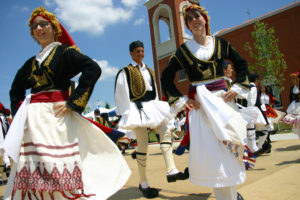 Folk dancing is a large part of Greek culture, ever present since the days of ancient Greece. Greece has thousands of unique dances, and each region has its own styles of variations. Many dances even have their roots in ancient times. For the Greek people, these dances are about more than just entertainment – they are a deep and significant part of the culture. Here is a look at the history of Greek folk dancing:
Folk dancing is a large part of Greek culture, ever present since the days of ancient Greece. Greece has thousands of unique dances, and each region has its own styles of variations. Many dances even have their roots in ancient times. For the Greek people, these dances are about more than just entertainment – they are a deep and significant part of the culture. Here is a look at the history of Greek folk dancing:
Origins of Greek Dance
There is some cultural evidence that dance existing in ancient Greece. Writers such as Plato, Aristotle, Plutarch, Herodotus, and Lucian mentioned dance, and it was even referenced in Homer’s The Iliad.
“The dance of the youths and maidens is distinctive. It is a ritual dance performed with great care, by dancers scrupulously dressed in their best garments. It is made up of a crisp, rapid, circular figure, followed by a movement of two lines in opposition to one another.”
In ancient Greece, dance was synonymous with being educated. Those who had received a good education were also taught how to dance. Each dance had a purpose, and some were even associated with religious celebrations. Other purposes for dance back then included to increase fertility, to prepare for war, to celebrate happy events like weddings, and even to cure an illness. There were even professional dancers in ancient Greece!
Characteristics of Greek Dancing
There are those who believe that today’s Greek dances have been derived from the dances that were common in ancient Greece. Although there are thousands of dances in Greece, most of them fall into one of the major categories of dances. Most dances are done in a circle, but there are some that are to be performed solo or with a partner. There was also a time when men and women were not allowed to dance together, but this is no longer the case. For example, many of the leaping dances were reserved only for men, but this has changed and women participate in them, as well.
Greek Dancing Today
There are several different categories of dance and for the most part, the dances are broken up by region. However, there are still some dances from ancient Greece that are still being danced today. The following is an overview:
- Ancient Greece: Dances include the Syrtos, Dionysiakos (part of the ancient cult of Dionysius), Choreia, and Pyrrhichios.
- Aegean Islands: The dances that originate from these islands are known for being fast and feature light movements. The dances include the Karavas, Ballas, Syrtos, and the Rhoditikos.
- Crete: The dances that are traditional to the island of Crete are usually fast and athletic and require a lot of stamina. These include the Angaliastos, Kanella, Rodo, and Sousta.
- Central Greece: Dances that are popular in central Greece include the Hassapiko, Syrtaki, Kalamatianos, Zeibekiko, and Tsamikos.
- Epirus: Dances from this region are slow and require a lot of balance. Dances include the Berati, Giatros, Klemata, and Sta Dio.
- Peloponnese: These dances are on the simple side and its common for the leader to improvise. Dances include the Kalamatianos, Tsamikos, Syrtos, and Geranos.
- Ionian Islands: Dances include the Bourdaris, Kerkiraikos, Levantitiks, amd Syrtos.
- Macedonia: Some of the dances are heavy and include deliberate steps and others are fast and have quicker steps. Dances include the Akritikos, Dimitroula, Kastorianos, and Hasapiko.
- Thessaly: This region also has dances that are on the heavy side, and like in the Peloponnese, the leaders have been known to improvise. Dances include the Dionysiakos, Kalamatiaons, Kleistos, Syrtos, and Zacharoula.
- Arvantites: The three most common dances here are the Ntarsa, Plektos, and Tsamikos.
- Thace: These dances are fast and light and only men are allowed to dance in the front of the line. Dances include the Baidouska, Drista, Gaitani, and Singathistos.
There are also other regions of the world that were known to have sizable Greek populations, such as Asia Minor and Pontus. While these regions are no longer part of the Greece, many of the Greek traditions do remain.
Greek dancing is truly part of the way of life. In order to really understand the Greek culture, it is a good idea to also learn some of the dances.
Kalamatianos Dance Instructions:
Zeibekiko Dance Instructions:
Tsamikos Dance Instructions:
Sources: